The first night my wife and I stayed at our log cabin it was raining. We had closed on our retirement home in West Tennessee and were excited for our inaugural stay after our purchase. Just as I was about to drift off into a peaceful sleep, I realized I’d left something outside.
[Editor’s Note: This story contains images of snakes and stories of snake encounters. If snakes make you sssssskittish, we’d suggest skipping this story! The rest of you will enjoy this excellent tale from Steve, and its important lessons.]
I hopped out of bed and walked to the sunroom where I slid open the patio door and started to step outside. My downward peripheral vision stopped me before I planted my bare foot right into the middle of a big snake curled up next to the door out of the rain. I literally hopped back inside and couldn’t slide the door back shut fast enough.
For the previous 54 years I had lived in northern Illinois where I endured the snow and below zero winter temperatures. Dealing with the cold meant that my only encounters with creatures that slithered were a few harmless garter snakes darting away when I pushed my lawnmower in their direction. My run ins were few over the decades, likely only about five times during my lifetime. Like many people, snakes gave me the willies and I wanted nothing to do with them.
I returned to the sunroom door, now wearing shoes, with my left hand shining a flashlight and my right hand gripping my Ruger Super Single Six. The .22 Magnum had its first shot ready to go with a blue CCI encapsulated shot shell. The single action was originally my father’s and he had it fully engraved by Jeff Flannery, including gold inlayed bands. I had brought this revolver along on this first visit because I wanted the first shot fired on our new property to be with the Ruger that my dad cherished.
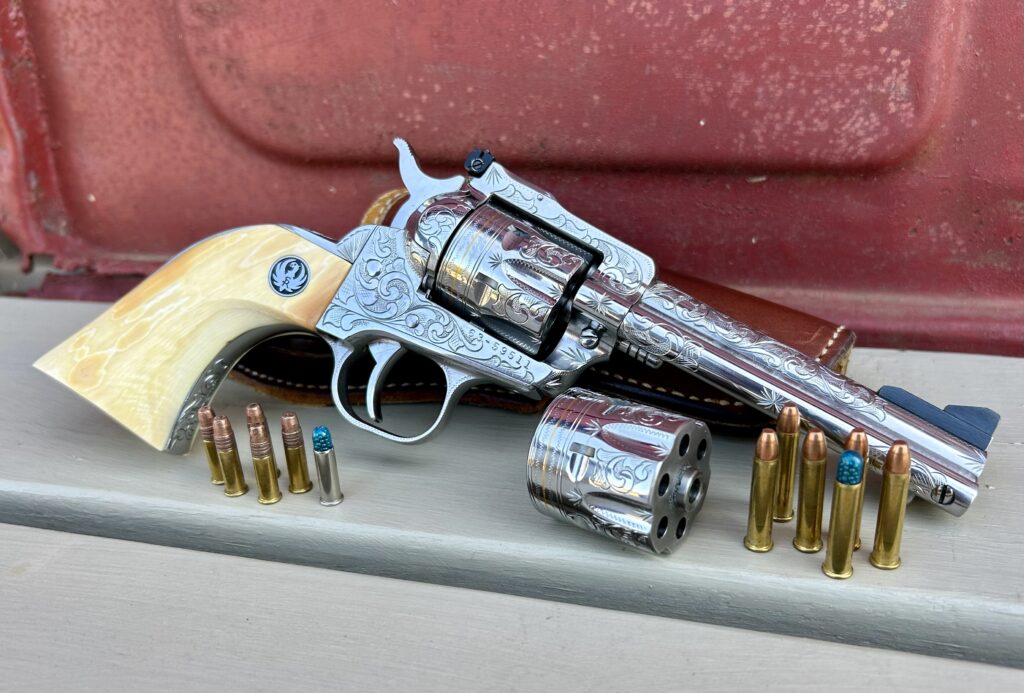
Its elephant ivory stocks were warm in my hand as I shined the light before opening the door, but the snake was gone. I carefully illuminated my path to accomplish my retrieval task and then returned to bed where I told my wife all about my exciting adventure.
Snakes have turned out to be an entirely new issue for me because they just weren’t a threat where I grew up. My parents had retired to a log cabin in the middle of Wisconsin and I spent lots of time visiting them. Snakes were even less of a problem there, where it got even colder during the winters.
By the way, I did fire the first round on our property at a steel target with my dad’s engraved Ruger with its .22 Magnum cylinder installed. Both the .22 Magnum and .22 long rifle cylinders are engraved and gold inlayed to match each other. I’ve since fired many rounds here with it and each trigger pull puts a smile on my face.
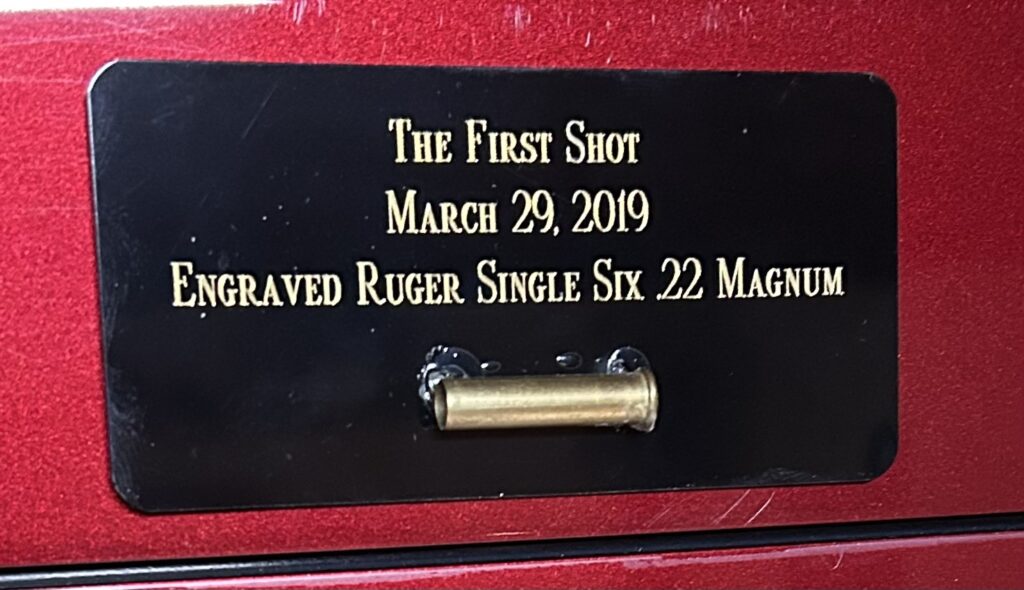
Do the Research
I quickly learned that down here in the South, cottonmouths, copperheads, timber rattlesnakes, and pygmy rattlesnakes are the known venomous residents in my area. Since this was all new to me, I talked with the locals and asked them about their snake experiences. It’s always a good idea to gather as much information as you can about your new neighborhood. It seemed everyone had a cottonmouth or copperhead tale, but no one had a rattlesnake encounter. One elderly gentleman imparted the knowledge upon me that “poisonous” means inhaled, swallowed, or absorbed, while “venomous” refers to injection. “There’s a difference, son. Venomous snakes are the bad ones, constrictors aren’t a threat to us.”
None of the stories I heard were about people getting bitten. The stories were about finding dangerous snakes in dark crevices or wide open spaces. Shovels seemed to be the most often utilized methods of decapitating the legless reptiles. Most farmers have this tool close at hand.
Warnings were plentiful to remain alert when moving wood piles and reaching into hidden spaces. I reminded myself to raise my awareness when removing my propane grill’s cover (the black tarp thing which revealed a copperhead one time), retrieving firewood (snakes of all kinds love all those crevices), and even rolling out the garbage in the roadside plastic can on wheels (the space under them is apparently quite appealing while the can sits motionless all week).
My wife still had two years to go before she could retire, so I drove back and forth from our home in Illinois to our cabin in Tennessee with our seventy pound Catahoula mix named Charlotte as my companion. I love this dog with all my heart. She is my world. She came across a garter snake in our backyard once and played with it for awhile before moving on. I knew she wouldn’t necessarily retreat automatically if she came face to face with a snake in the Volunteer State. Tennessee law prohibits the hunting of snakes, but an exception is made if a snake (venomous or not) threatens humans, livestock, or pets.
After one particular trip’s drive (it takes about eight and a half hours one way), Charlotte and I arrived at the cabin at 1 o’clock in the afternoon. I put my vehicle in park and Charlotte excitedly leapt out with her tail wagging. Then she immediately stopped at the corner of our lake, just a few feet from where I had parked. I saw that she had alerted on something and I sternly called her back.
I peered at the edge of the water where the grass and weeds were high and there lay a cottonmouth, its white mouth wide open, displaying its fangs and not backing down. I kept Charlotte back and she obeyed. I think she knew that the snake was not retreating and she understood it was dangerous, probably also because of my tone. I brought her into the cabin and retrieved a revolver from my gun safe. I kept this particular S&W Model 686 .357 Magnum with its 6-inch barrel locked up at the cabin as a “do it all” kind of gun.
When I came back outside, the cottonmouth (also called a water moccasin – there are so many colloquial and regional names for snakes!) hadn’t moved and still threatened us with its gaping white cotton mouth. I cocked the S&W’s hammer single action and the cylinder rotated a CCI .38 shot shell in line with the barrel. When I pulled the trigger, that was the end of this particular snake.
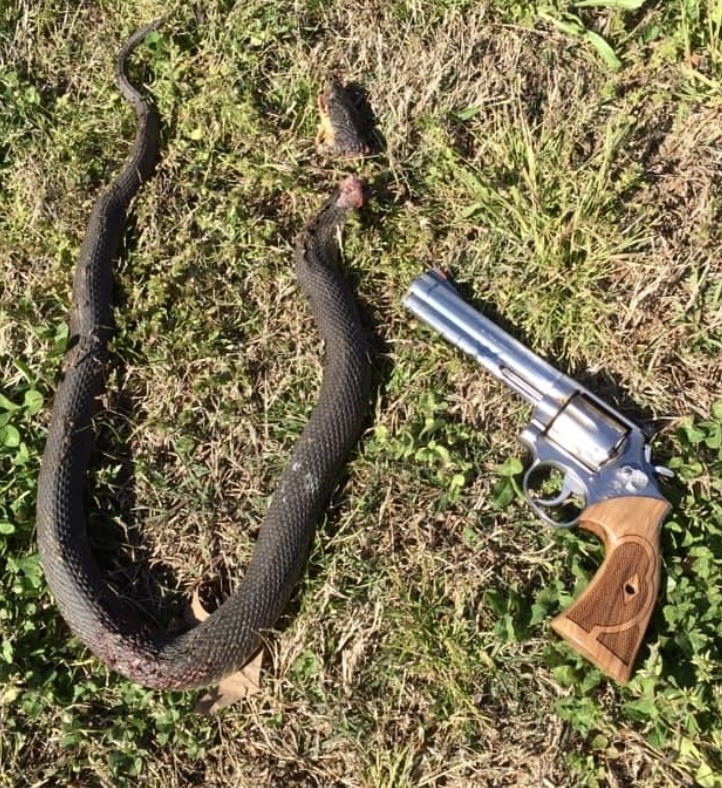
I had been warned by neighbors about improper disposal of dispatched snakes when it comes to having a dog. I was told to bury the head deep so a dog couldn’t dig it up and eat the head along with its venom sacks. Making my job easier than burying the snake head were the turtles in our lake. Tossing the body into the water is like chumming the ocean for sharks. The turtles are big and ate up the cottonmouth readily.
snake guns and loads
The revolver is the natural vessel for the CCI snake shot load. The blue plastic .38 Special cartridge holds 100 grains of #9 shot and patterns well for when a snake must be terminated. The pattern is sufficient at the distance where it’s necessary to shoot instead of backing away. This also means that when a snake must be killed, the pattern is dense enough where you don’t have to get too close to the business end of the creature.
Ed Head (retired from the Border Patrol and who has sadly now passed away) wrote an excellent article in 2015 that covered everything you’ll ever need to know about the CCI blue shot shell loadings. Ed’s follow up article about the more powerful red capsule loadings that CCI subsequently offered is also excellent. These are called “Big 4” because they contain #4 shot instead of #9 or #12 in the blue capsules.
Part III of Mike’s series on the Lipsey’s – Smith & Wesson Ultimate Carry J-Frames covered Doubletap Ammunition’s DT SnakeShot ammo, available in .32 H&R Magnum, .38 Special, and five other handgun calibers. The .38 Special version consists of 70 grains (140 pieces) of #9 shot and adds a 50-grain hardcast wadcutter to make a first shot snake-worthy, or much larger threat-worthy.
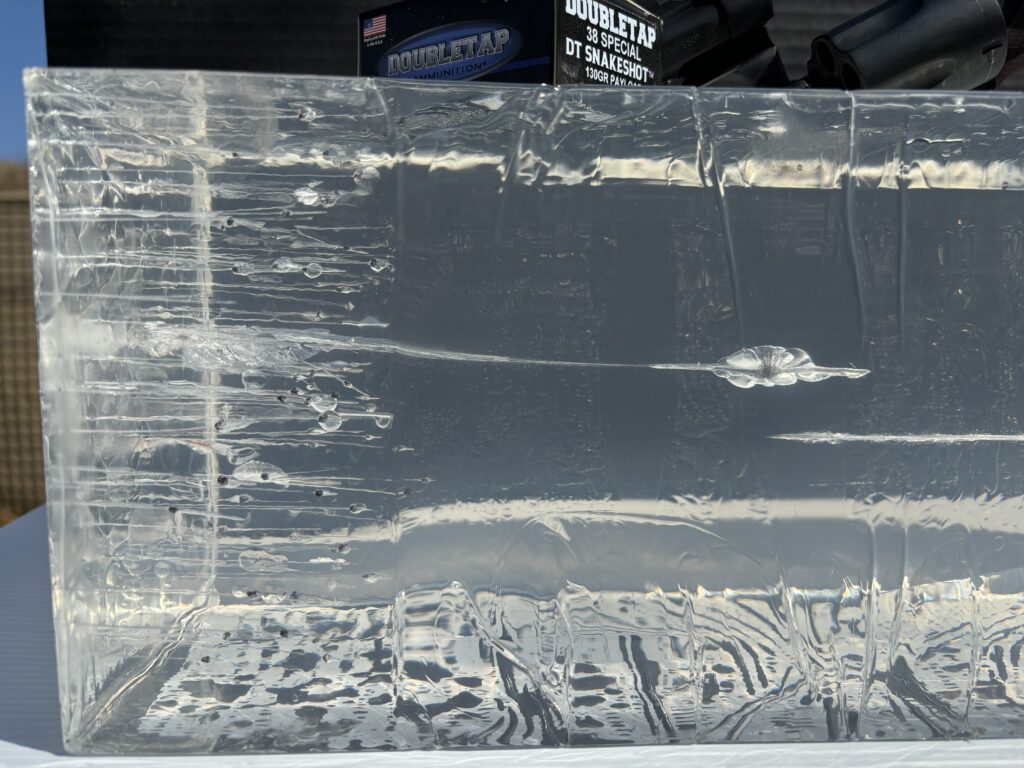
While semi-automatics can safely fire CCI shot shells (and are offered in 9mm, .40 S&W, and .45 ACP chambering), they most likely will not reliably properly function the pistol’s action. Keeping a shot shell chambered with the knowledge that manual cycling of the slide or clearing of the action is necessary for follow up shots is the way to go.


But again, the revolver is the natural home for snake loads, which work very well in them. My big 686 isn’t difficult for me to carry in a cross draw holster, but it’s not all that comfortable or convenient either, due to its weight and long length.
My S&W Model 40-1 Centennial, in my dad’s old Clark holster, is much easier to tote on my right hip, with its short, two-inch barrel length. This 2007 model was the first gun I reviewed back when I was writing for a trio of law enforcement magazines (Tactical Response, Law & Order, and The Police Marksman). It’s nickel plated with an internal hammer, no lock, and the original Centennial’s grip safety. For my big hands, the grip safety always worked intuitively along with a Tyler T-Grip and I never felt that the gun wouldn’t go off because somehow I wasn’t pressing the grip safety all the time. But I did find that some people’s hands didn’t work as well as mine in conjunction with the safety device.
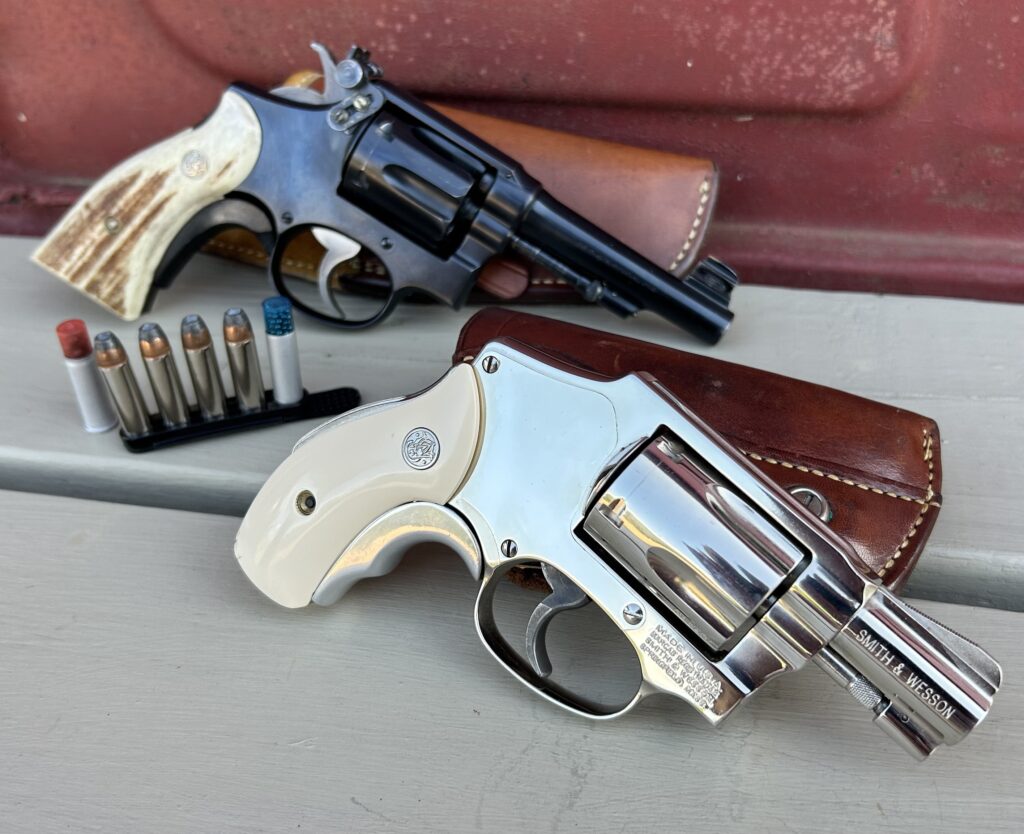
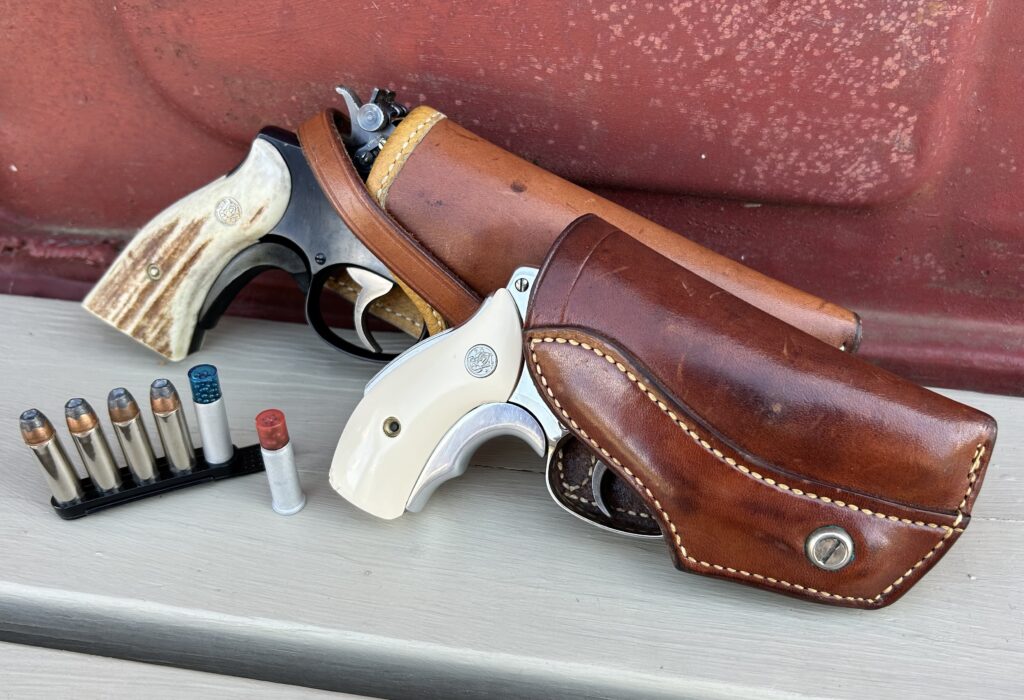
The leather Clark rig features a single belt loop to secure it to my side and that makes it very quick when putting it on and taking it off. Rob Leahy at Simply Rugged Holsters made me one of his Silver Dollar Pancake holsters out of a beaver tail I sent him from a beaver I shot on our lake. It features two belt slots and holds the gun tighter to my side than the Clark. Rob’s design protects the gun with plenty of coverage. It’s a little more difficult to put on, slipping my belt through the first slot, then weaving it through my pants loop while contorting myself, and then pulling my belt through the second loop. But its comfy and secure.
Back before I was born, my dad made a pair of walnut stocks to fit his old S&W Chief’s Special flat latch (pre-Model 36). The gun is long gone, but I still had the stocks, tucked away in my “box o grips”. They fit my hands wonderfully, but unfortunately didn’t work on my Centennial because of its grip safety.
I found a S&W Performance Center Model 637 for sale on the used market and bought it because of its PC attributes and the fact that I could secure my dad’s old handmade walnut stocks on its round butt grip frame. It turned out to be a perfect match. The 637 offers a terrific trigger pull in both double action and single action, along with the lighter carry weight of its aluminum frame. I also like the exposed hammer so I can cock the gun for carefully aimed shots at a snakes. Carried in the beaver tail holster, I forget it’s even on my hip, despite packing it all day. Touching the walnut handles reminds me of my dad and always brings a smile to my face.
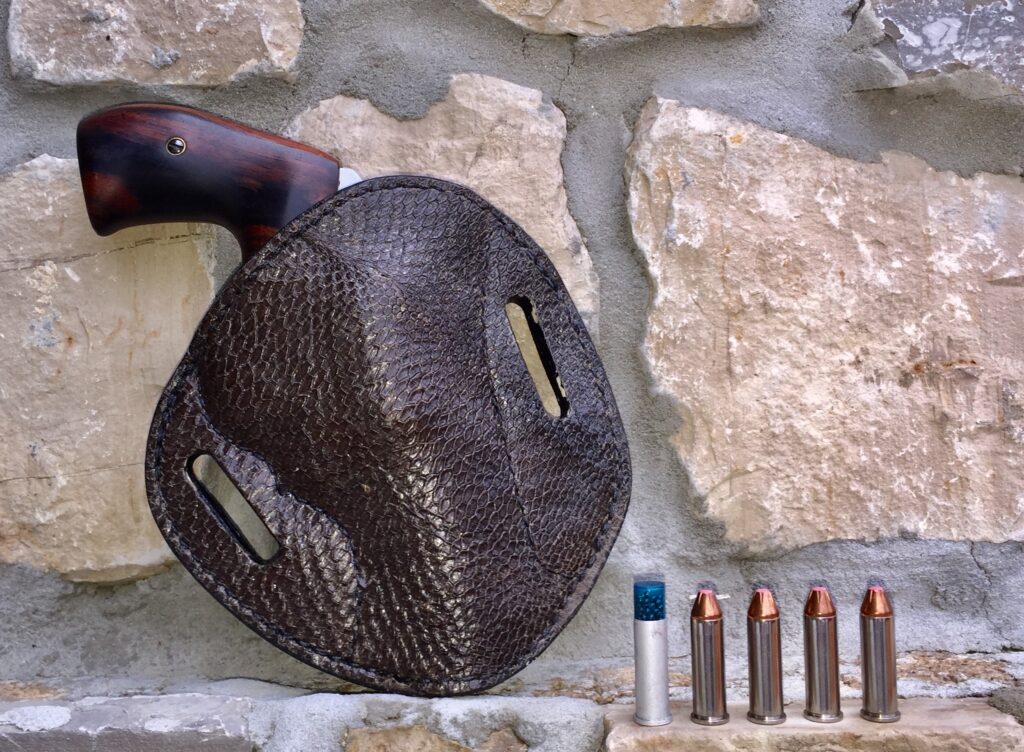
The S&W 637 has become my everyday companion here at our log cabin home while out working in the yard, the woods or the fields, on the tractor or the Polaris Ranger. I have the five shooter loaded with a .38 shot shell, followed by four Hornady Critical Defense rounds. A five shot speed strip in my pocket supplies another shot shell and four more hollow points.
A follow up shot shell might be needed in case one of the pellets fails to find its mark and a snake keeps squirming. However, in practice that situation has yet to happen. I have fired a second shot on a snake, but it was a hollow point, carefully aimed single action, to finish the creature off.
You Just Never Know When
One beautiful day I was walking a trail with a fellow retired co-worker of mine who came for a visit with his wife. My eyes are always scanning several dozen feet in front of me when I walk out there, and not just for snakes, but for things that might try to twist my ankle or otherwise topple me to the ground. The field road is made of rocks and the big ones seem to oddly rise up to with the intent to get me. A snake appeared up ahead in our path and I quickly drew my S&W and had it pointed in my grip. I wasn’t going to outdraw Doc Holliday, but my friend and his wife (both also from northern Illinois) were startled to see the snake.
I laughed inwardly to myself when my friend’s wife said, “Did you see how fast he drew his gun?” I re-holstered because it was just a gray rat snake. They’re the most common non-venomous constrictor snakes in the area. Since I don’t have chickens with eggs to worry about, the rat snakes are welcome. They actually will eat the venomous snakes. I certainly don’t want to shoot any of the good snakes we share the land with.
I have encountered the dangerous ones further out on our property, but I leave them alone since they’re not an immediate threat to us or our dog. I hope they won’t find there way closer, but if they are found by the house, they’re not going to be there long.
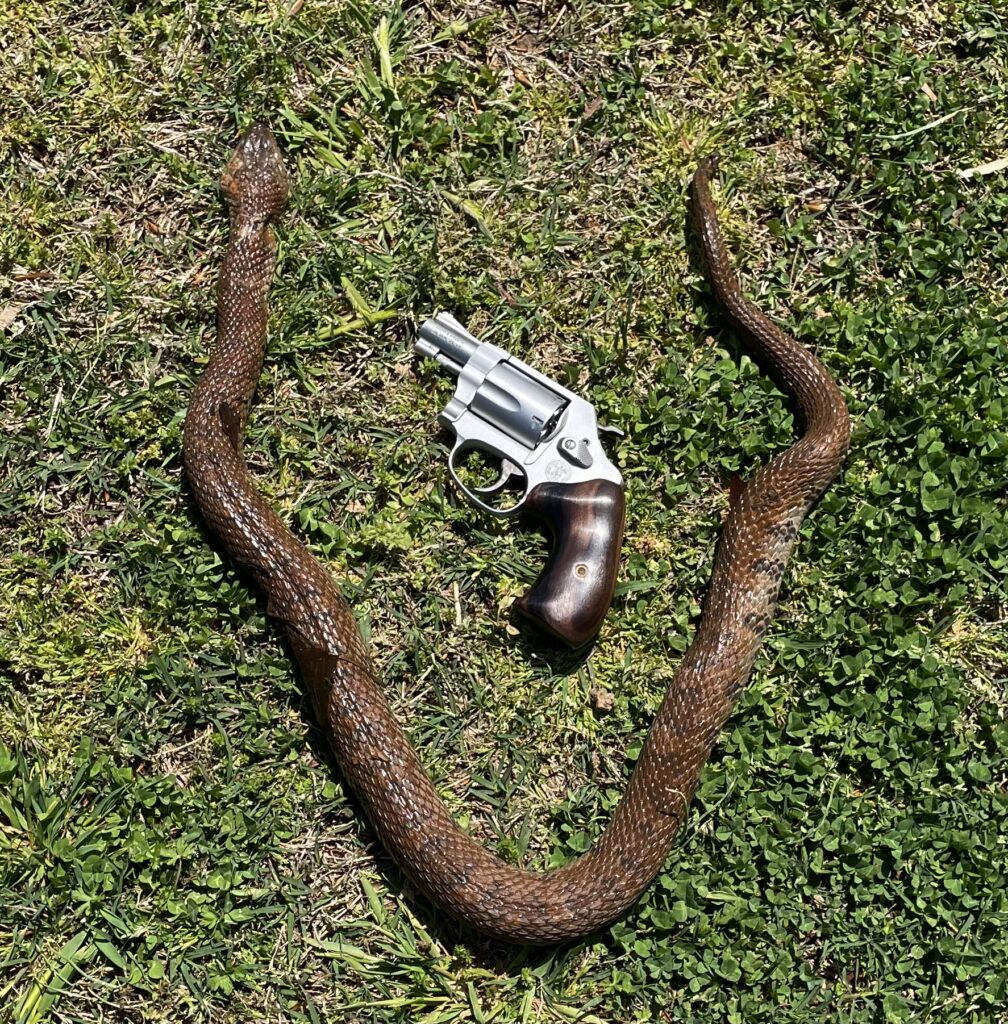
Eye to Eye
We have a two person, trolling motor fishing boat for use on our small lake, and one day during our first Spring here, my wife and I took it out for a little float tour. Afterward, we climbed out of it and into our small boathouse. My wife got out first and then I scrambled up onto the walkway and came face to face with a snake. At first I thought it was a crow bar on the shelf that I didn’t realize was there. It’s funny how your brain will process things and attempt to form a logical reason for what your eyes are seeing. Rat snakes will kink their bodies and that’s what made it look like a crow bar. I realized it was a big snake in half a second and pushed my wife gently forward while saying, “Move forward, go, go, go, keep moving.” I got her away and then shook the “willies” off of my arms and legs.
I used my phone’s camera to take a picture from a distance and zoomed in to try and identify the snake. This was an exercise in dexterity since I had my phone in my left hand and my revolver in my right. This was an early encounter when I was just beginning to learn about my newfound snakey compadres. As crazy as it sounds, most non-venomous snakes have round eyes and the danger noodles have vertical pupils. The joke of course is, “Who wants to be that close to be able to tell the difference?” There is also a difference in their skin’s scale/plate structure around their anal opening. Again, “Who wants to be that close?”
This snake had round eyes. It was just another gray rat snake, the friendly kind to humans. It also had a rounded head, unlike the venomous snakes’ more triangular head that contains its venom sacs. Some constrictors will flatten their heads to try and look like a venomous snake to cause other animals (and humans) to avoid them. That’s a dumb move for a non-venomous snake to make a human thinks it’s a venomous snake, right? Good thing we have bigger brains and can choose to leave them alone.
Most venomous snakes that can cause us a trip to the hospital are also relatively short and fat. The good snakes are usually long and thin, the better to squeeze their prey with.
It’s taken me a few years, but I can identify them fairly quickly these days. When I’m on my zero turn mower and I see a snake in my path, I slow right down. There have been times when I’ve been able to quickly tell that the long, black snake (stretching over five feet across my path) is just a black racer and I’ve stopped to let him pass through.
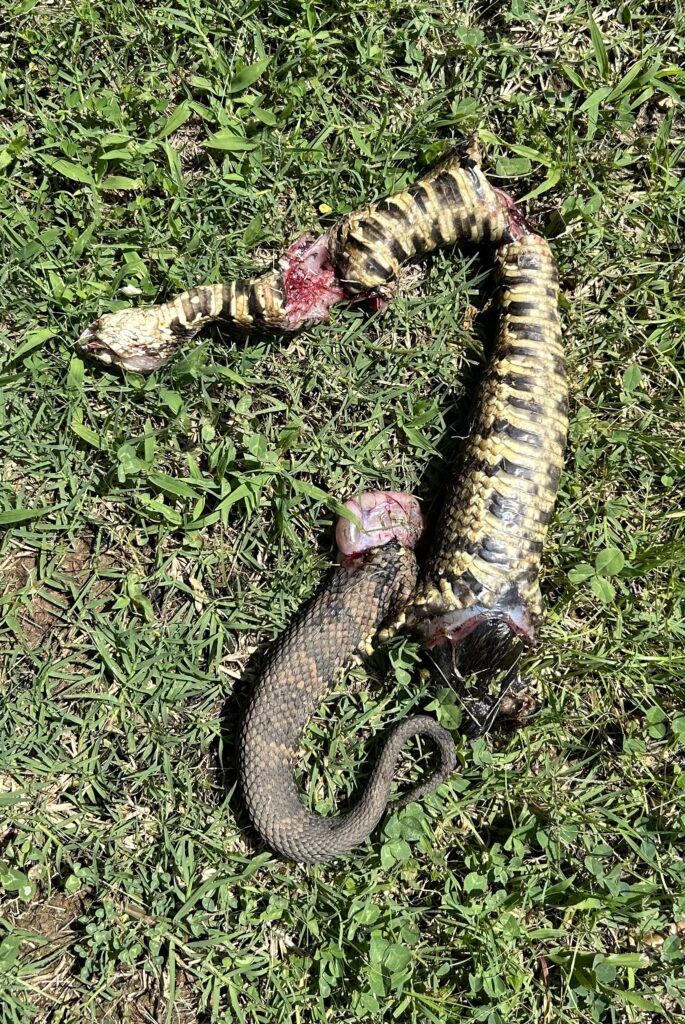
But in that same split second, I’ve identified a short, thick, snake as a cottonmouth only a few feet from the water and I’ve pushed the mower’s controls forward to speed up and run it over and grind it up.
There was a time when we were still new to our cabin and any snake caused me to immediately back off. Today, I pause and reach for my sidearm while deciding if I need to draw or not. I try to think ahead before opening things where a snake could be, or removing the cover on our propane grill. I prepare myself mentally in case a snake appears, often with my hand already on my dad’s hand made walnut stocks.
more snake Guns
I’ve used the already mentioned S&W Models 686, 40-1, and 637 to dispatch the venomous reptiles, but I’ve also used a Taylor and Company Model 1875 Outlaw chambered in 9mm. The CCI 9mm shot shell works great in this capacity.
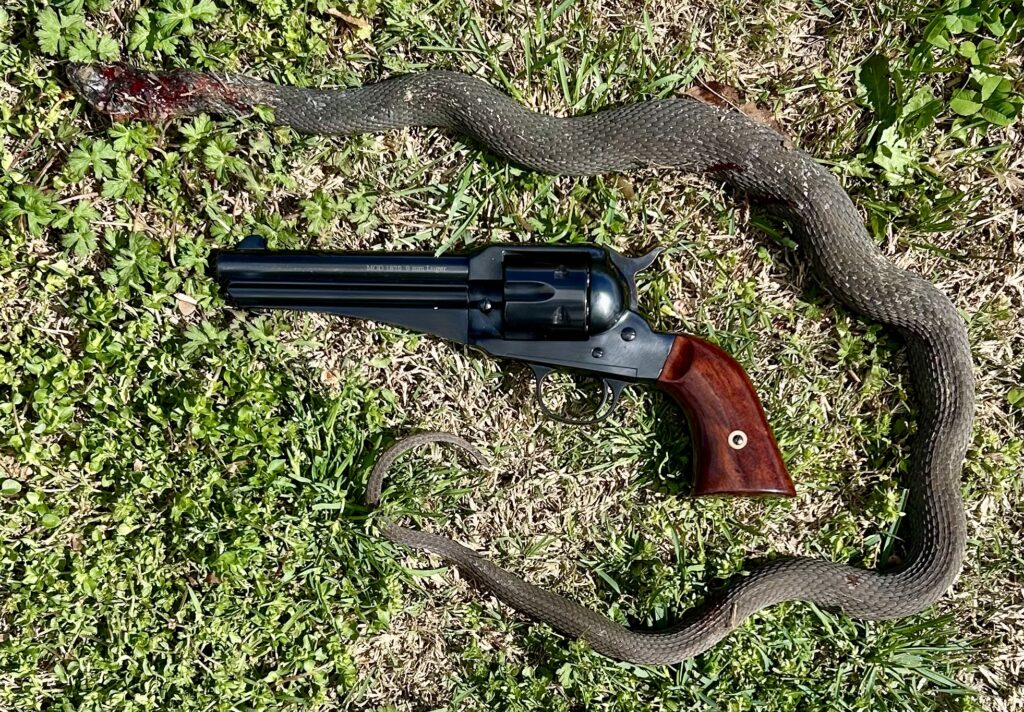
My wife carries a Ruger Wrangler Birdshead .22 in one of my dad’s old El Paso Saddlery leather holsters or a belly band holster when she’s out cutting the encroaching branches that grow continuously into our trails.
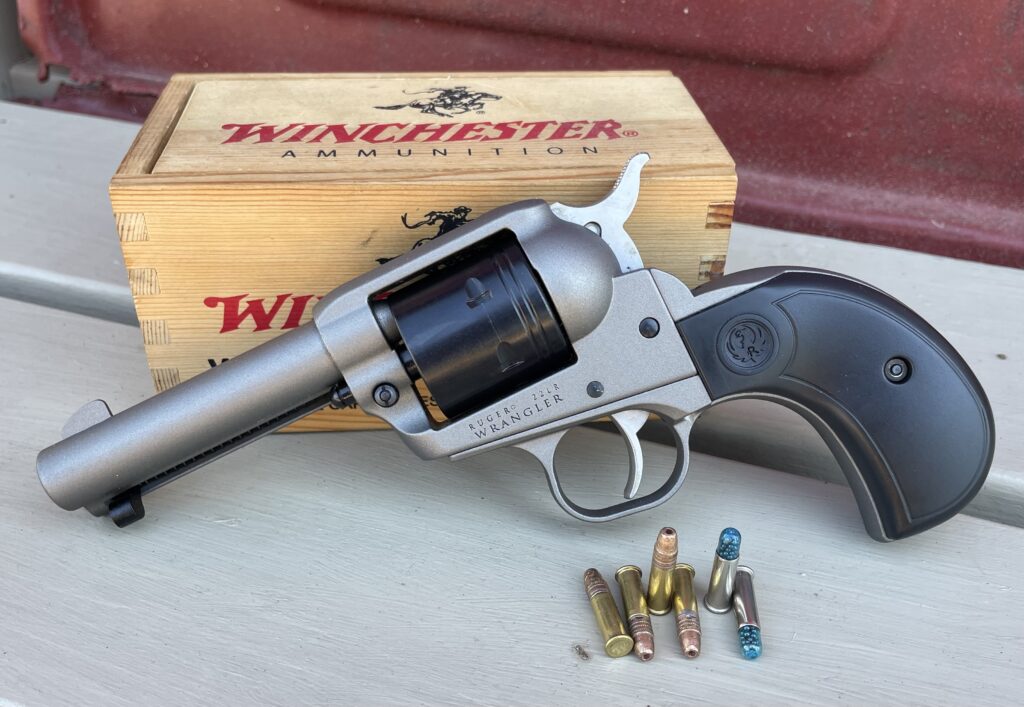
I was headed out to the fields one morning on my old ’55 Ford tractor and my wife was following behind me, driving our Polaris Ranger. We were moving along fairly quickly when I saw a cottonmouth in the middle of the field road. The tractor’s wheel track is so wide that I couldn’t swerve enough to run it over.
The wind picked up and suddenly blew my hat off. In a nanosecond, my brain imagined the hat falling on top of the snake. Then I pictured my wife stopping to avoid running over my hat and getting out of the Polaris to retrieve it. I pictured her reaching down to grab my hat and then being bitten by the snake hidden under the hat.
I stopped the tractor and got down off it, only to see my wife already out of the Polaris and keeping her distance with her gun drawn and pointed at the cottonmouth. I waved her off and shot the snake in the head with my Performance Center .38 Special. We remounted our engine driven steeds and proceeded with our work out in the fields. I smiled to myself, knowing my wife is perfectly capable of handling nope ropes. We later tossed the snake into the lake for the turtles.
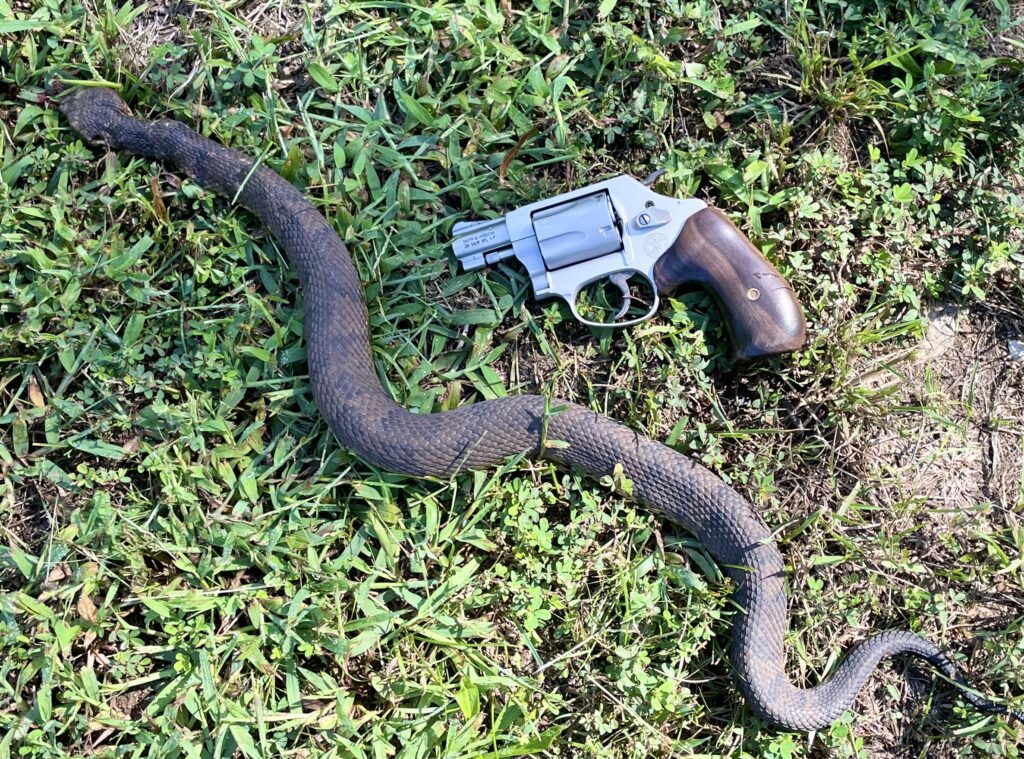
I have CCI shot shells in .44 Special that can be fired in that chambering or in .44 Magnums, but I have yet to shoot one at a snake. The little S&W .38 snubby with its lightweight frame goes everywhere with me and its my “go to” gun because it’s so handy and easy to pack on my hip.
Similarities to Snakes
During my law enforcement career, I obviously never wanted to shoot an innocent person. I wouldn’t hesitate to defend myself or another against a criminal who was intent on causing great bodily harm or death. That decision needs to be made in a split second.
There were a few times when I had my hand on my holstered duty gun or it was drawn and the decision to fire was a life and death matter. For reasons of luck, sound tactics, or stern verbal control (or their combinations), I never had to fire my duty weapons (handgun, shotgun, or rifle) at another person during my thirty year career.
I see the same discretion in my mindset when it comes to deadly snakes, or just those who slither around looking to eat a mouse. I find it interesting that I apply a similar approach to the snakes here at our retirement cabin. I leave the gray rat snakes, black racers, and green snakes and other non-venomous ones alone. They may still startle me when they appear in places they’re not expected (like inside the garage!), but I let them slither away. I even had a gray rat snake halfway through the front wheel of our parked vehicle that I had to coerce out of there, otherwise it would have been cut in two (or more pieces) when we drove away.
There’s a saying that if you have to ask yourself, “How in the world did that snake get there?” then it’s definitely a gray rat snake. They eat bird eggs out of bird houses and love to eat eggs in chicken houses. That’s why they’re often called chicken snakes too.
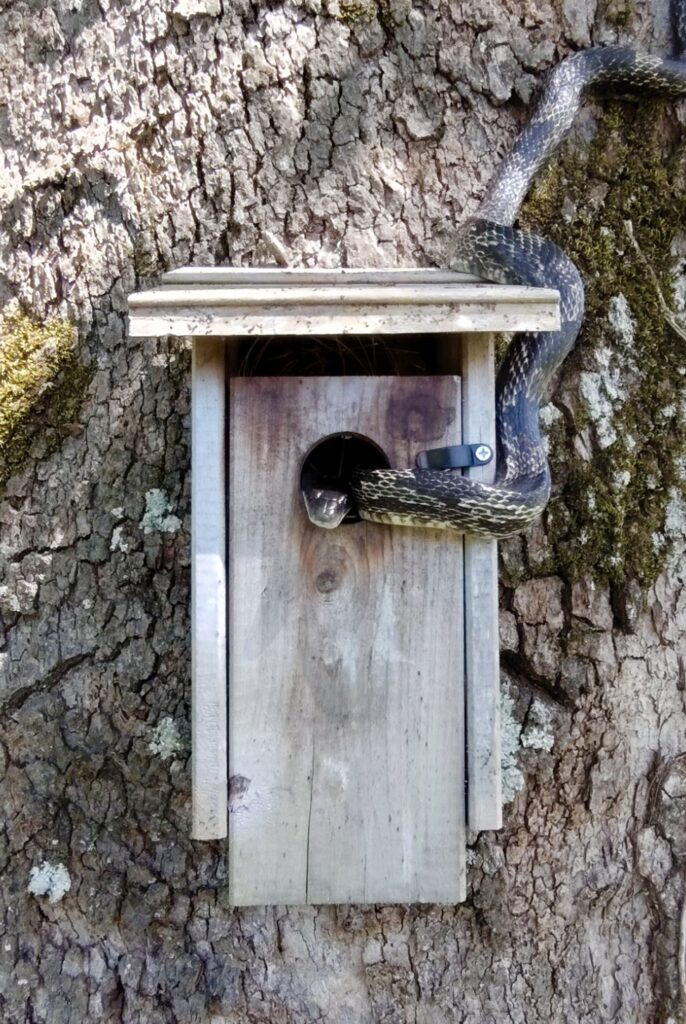
Even the venomous snakes can go about their business if they’re out in the fields or the woods far from our home. I know they can be bad news, but they’re not an immediate threat so they live to enjoy their day.
But if the bad ones are close to the house where they pose a threat to my safety, or the safety of my wife, our dog, or our visitors . . . well, that snake is going to become turtle food right quick.
The comparison of venomous snakes to dangerous people is an interesting one. Colonel Jeff Cooper’s Color Code of Awareness applies to many situations, not just humans.
Condition White (unaware and unprepared) is a big mistake when lifting a log off a pile to put into the fireplace. Even Condition Yellow (relaxed alert) isn’t enough when there may be a snake ready to strike under that log. Yellow is for walking to the pile of logs, Condition Orange is the proper state of awareness for lifting the log. You’re ready for there to be a snake. You have a plan to transition immediately to Condition Red, which is taking action and shooting the snake.
When we moved to Tennessee, I asked my newfound friends and neighbors about snakes. I also asked them about local crime and weather conditions. I wanted to know how often the power went out due to storms and how quickly the electric company got it back on. I asked about law enforcement response times, fire, and ambulance. I wanted to know where the closest hospital was and where the best hospital was (they’re not always the same).
Thinking about the exposure to snakes in my new living environment, it’s similar to how everyone should treat their own personal environment in regards to their fellow human beings. You want to ask your friends and neighbors about crime. You want to inquire about certain areas, like stores, malls, dangerous residential areas, where not to go after dark or maybe even during the day.
Hopefully there are no bad areas to be avoided where you live. But even then, good people may pop up and surprise you just like a gray rat snake. Make sure you’re in Condition Yellow. That way if someone “pops up” that is a threat, you can transition to Condition Orange (and maybe even Red if necessary) if it turns out to be a copperhead or cottonmouth kind of person . . . a threat to your life that is just too close to home.
Every day in the late afternoon, Charlotte and I walk out along our lake’s levee and into the field out back. It’s just a three minute walk. Charlotte does her business and I bring a small bucket of corn to dump out for the deer. I must have done this daily ritual well over a thousand times. My dad did the same thing at his cabin in Wisconsin.
During all those short walks, I never saw a snake of any kind . . . until I did. Many times I had a sixgun on my side, but sometimes I didn’t. Just this one time, as we were on the levee and Charlotte was behind me, I saw a copperhead in the grass directly ahead in my path. I stopped my dog and we walked back to the cabin. I armed myself, with the often repeated phrase, “the first rule is to have a gun” echoing in my head.
When we got back to the spot where I had seen the venomous snake, I used extreme caution, but it was gone. Thinking about the one-in-a-thousand chance that just showed itself, I beat myself up a little more about not having a gun on my hip.
The interesting thing about that incident is that every time I’ve walked past that spot since, I think about that snake and I look for it. As a matter of fact, everywhere I have encountered a snake has stayed in my mind. I suppose it’s a survival kind of thing.
I also suppose that if you walked through a parking garage a thousand times until the one time an armed robber threatened you, you’d never walk past that spot again without thinking about it. If you’re a RevolverGuy, you probably had a gun on you, and if you didn’t, you probably will the next thousand times you found yourself in that position.
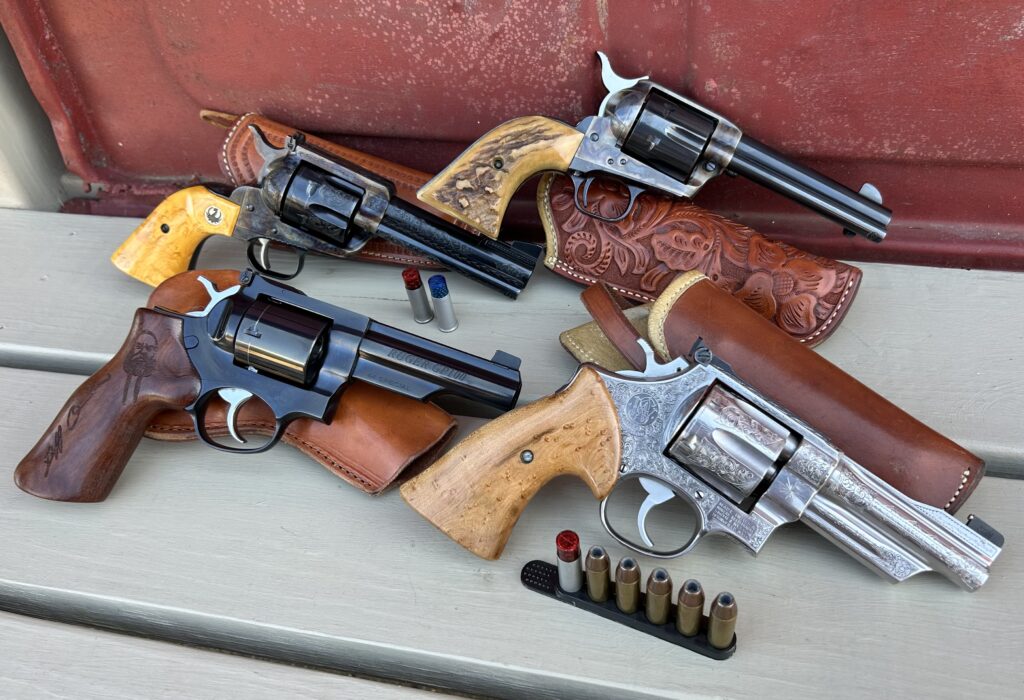
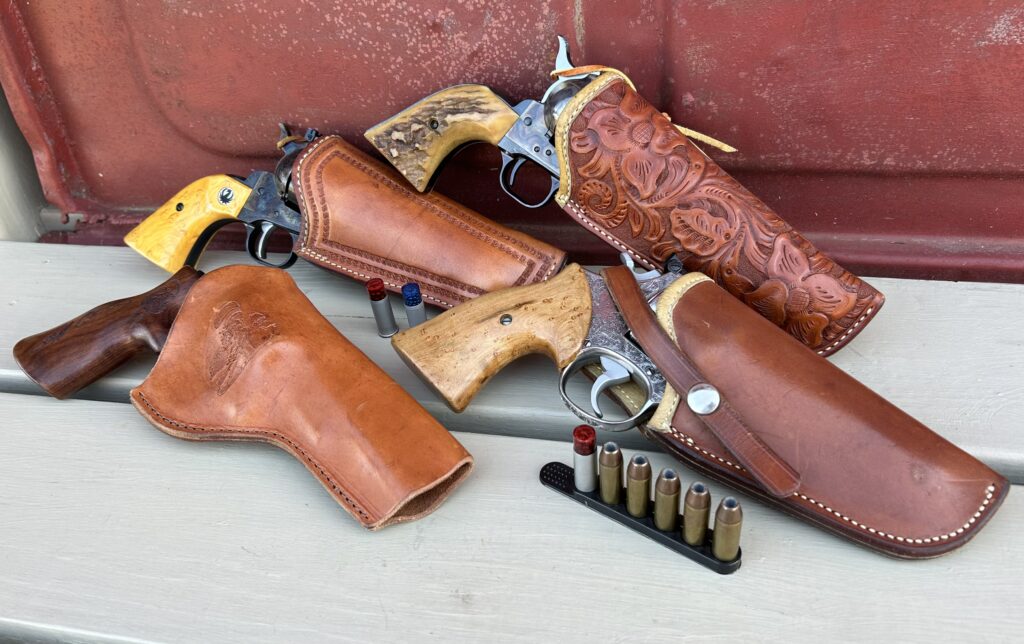
the final word
There are good snakes and bad snakes. There are rattlesnakes that warn you ahead of time to keep your distance. There are venomous snakes that will bite you just because you weren’t paying attention and reached toward them and they took it as a threat. There are non-venomous snakes just going about their own business, but happen to spook you when they appear where they weren’t expected.
These same situations happen with human encounters. We don’t always see them coming, but we should prepare for what to do when they happen. We train to not be surprised, but even the best of us can’t be ready for everything all the time. Even if startled, the question to be answered is how quick will your response be and will it be the proper action?

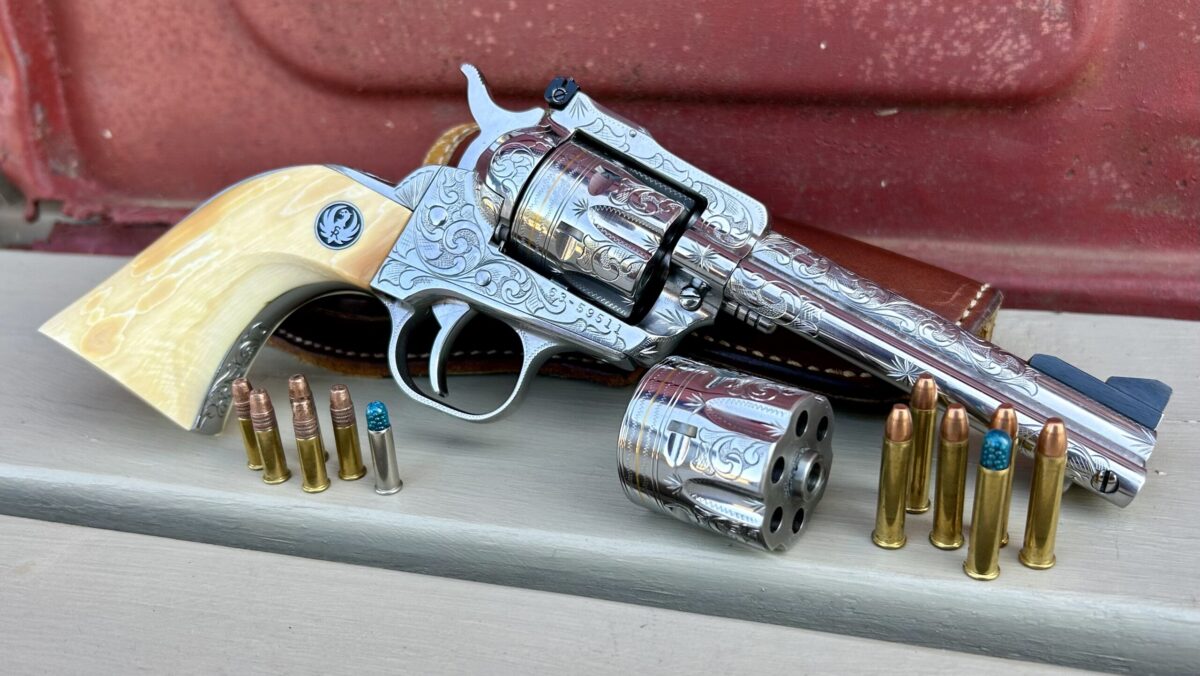
Great article Steve. Your taste in snake dispatching iron ( grips & leather too ) is impeccable.
You do reside in the land of snakes, me too for my three score , ten and then some. Grew up being entertained/spooked by elders telling me snake tales. Some of them darned scary for a little kid.
In all these years I have had first hand knowledge of one serious bite and one fatal bite. Both had a touch of stupid that contributed to their injuries. One tried to shoo a pygmy rattlesnake into a rubber tub to remove it from inside a lodge. It got him on the hand and he spent several days in the hospital on death’s door. The other had a “pet” rattler , shades of that old film “Stanley”. He frequented a state line tavern and walked in one day with his “pet” wrapped around his neck. He was rolled out on a gurney with a sheet over his head.
Always enjoy your wonderful articles especially with your images. Glad you are down south now.
Thank you.
Thanks Tony! Sounds like those elders’ stories provided sound advice taken to heart, likely because of their entertainment/spooky nature! I think you’re right about a touch of stupidity or carelessness being the #1 cause of snake bites! Glad you enjoy the articles and I sure am glad to be down south!
The only truly dangerous snakes in my burg are politicians, though there are lots of creepy homeless street snakes slithering around and causing mischief. Still, excellent advice in this article for those who live around bad serpents. That CCI .38 Special shot shell does a fine job on those nasty critters.
Really great looking revolvers and holsters featured in Steven’s story, too. A fine addition to that battery, and very appropriate for this topic, would be one of Colt’s “Snake Guns” like the Python, Cobra, Viper, etc.
Interestingly, my Colt revolvers aren’t “snake” named. I could use them for dispatching slithering creatures, but none of have snake names from the factory. I should really remedy that one of these days!
I almost didn’t get to read the body of this excellent article as I was fixated at the gorgeous Ruger Super Single Six at the lead. Glad I did, though, because you have some beautiful guns there. Your experiences coming from the north into the south as it pertains to slithering things is very common.
Grown up in Orlando (Before Disney – oh, them was the days), learning about venomous snakes as a kid tended to increase the odds of keeping you out of the emergency room. We were inside city limits with nearly as many lakes as traffic lights, or so it seemed. There were two good sized lakes in the area I grew up. No one swam in the lakes unless you were crazy, drunk, wanted to be nipped by a snapping turtle, bitten by water moccasins, or if you were really unlucky, chomped on by an ancient pre-historic lizard (alligator), assuming said lizard hadn’t meandered over to another lake. Our lake gave us water moccasins mostly, but we had our share of rattlers coming into the yard. Rattlesnakes would rather run than fight, Copperheads would rather hide and hope you didn’t step on or otherwise disturb them, but Cottonmouths – they were just plain nasty and even aggressive. Snapping turtles were another matter.
Years passed, and once on the job, it was easier to get away with shooting venomous snakes without public outcry, and minimum post-discharge paperwork. With the introduction of O.C. – pepper spray – a new and effective means of distracting venomous snakes arrived.
Fox Labs OC spray and pit vipers do not get along. Rattlers, Cottonmouths, and Copperheads, actually, pit adders, all have a heat-sensing pit organ located between the eye and the nostril on both sides of the head. BTW, all venomous snakes in the U.S. have hemotoxic venom. A good dose of pepper spray on a viper is like humans popping a speed ball (heroin and cocaine mix) while chugging on a bottle of Jack Daniels – we’ll be down for the count.
I currently reside in an suburban area in northern Georgia that has a number of heavily wooded and watershed areas for parks, many of those parks being along the Chattahoochee River. Setting off a .22 or .38 with snake shot won’t go over too well, even with the deceased evidence at the scene when the blue light brigade arrives. Walking along the cement pathways with my 9-Iron and OC, I’ve encountered many a copperhead and cottonmouth, and a squirt of OC spray does a nasty number on them, and the 9-Iron chips them nicely into the woods, or the water. When out in the very rural area, I do like to dispatch them with the aid of shot and gunpowder.
In time, you’ll have enough practice to hit the viper in the head with a .22 hollowpoint. That’s satisfaction. : )
I agree with you, S. Bond, that Steven’s engraved Ruger Single Six is a gorgeous revolver. I’ve seen some fine Single Sixes, but none comes close to that one.
We occasionally run across rattlers here on our hikes, and it never occurred to me to give them the hot sauce, if needed. Thanks for that, Sir! A great solution that will avoid attracting unwanted attention with gunplay.
The rattlers here are usually very polite, and give you ample warning that you’re making them unhappy, so you can divert. They don’t bother me, but cottonmouths are another story. Snakes in the water? Sounds like the stuff of horror movies. I think I’d look like Pancho Villa with bandoliers full of shotshells across my chest if I lived in those parts. ; ^ )
I’ve got a Pancho Villa costume ready for you Mike!
😁
S. Bond, when my dad was on his death bed and we were talking about which guns I should keep, the engraved Single Six was first on my list. That was actually a 6 1/2″ barreled gun because when my dad first bought it, the stainless steel versions weren’t made with the 4 5/8″ barrel. So my dad cut the barrel down himself and remounted the front sight. I remember watching him re-crown the muzzle with small hand files. When he turned it over to Jeff Flannery at a big gun show (Flannery would be engraving at his table while also talking to customers!), I was there. When my dad put the ivories on the gun, I was there. It was one I really wanted to keep and that’s why it was the gun used to fire the first shot here at our cabin.
9 irons and OC spray, now that’s a quiet combo!
Great article Sir! You bring up plenty of valuable lessons. I am sure most people these days carry a sidearm for the potential need of defending themselves against 2-legged venomous snakes, but it is important to remember, a reliable sidearm is just as necessary and possibly more frequently needed to deal with other wild threats on the homestead, the walking trail, or fishing trip. I personally carry a Smith 442UC all day every day unless I swap it out with a larger frame .357 depending on the tasks of the day.
I really appreciate what you said about passing a spot 1,000 times and being aware of a previous encounter. My previous police life has instilled that same habit in me as I go about my routines. Thankfully, the “snake” is not there when I look but I remain alert to the possibility. Thank you for a great read.
Thanks Mark! You sure can’t go wrong with a 442UC!
Steven, excellent post. I too have lots of encounters with nope-ropes on our chicken farm. All the bad ones are Copperheads. Too cold in winter here for Cottonmouths. Glad for that! This year only 4, one a baby (very dangerous and dispatched with a hoe). Some years it’s been a dozen. One livestock dog was bitten several years back, luckily in her nose! She was on antibiotics for 2 weeks. On a limb can be fatal to a dog (or you may end up with a three-leg dog).
Our resident rat snake has been with us five years. He’s big now, and he eats an egg sometimes to collect his pay, but he’s a terror to Copperheads and so used to us that I can put on fireplace gloves and move him if I need to when we have baby chicks. In about a month, he’s back sleeping in a nest box or stretched out with the hens stepping over him.
Some newcomers to the country kill all snakes, which is a shame. The black racers and rat snakes outcompete the copperheads here. These nonvenomous snakes do go hibernate a little earlier, so there’s a nasty window in mid-Fall where you can run into trouble. I shot a Copperhead about 2 feet from me with a Bond Arm’s .357 derringer about this time last year, while planting onions. I keep the little gun in my garden basket!
We found that CCI shot shells can lock up a short-barrel revolver if you load more than one in the cylinder. There’s a good deal of capsule jump after a shot. Even my handloads with capsules and a light roll crimp can do that.
For that reason (my wife or I like a second shot) I worked up a load of 3.0 grains of Bullseye, an overshot wad, #9 shot, a top card, and then nail polish to seal the deal. It’s a popgun load but handles Copperheads well. Watch your step and keep posting!
That’s valuable info about the bullet pull, Wheelgunner. Thanks for sharing that!
Old School Wheelgunner, that’s good advice about loading more than one CCI shot shell in a revolver’s cylinder!
One of the copperheads I had to shoot here was a small one. The claim is that the little ones will inject ALL of their venom if they bite because they don’t know to control how much to put out. Yikes! The little ones need to be treated with extreme prejudice!
So does the color of nail polish need to be a certain shade for your handload? 🙂
Steve, “Prince” Purple Rain is our latest color! I admit the shells look mighty purty 😀 The Dollar Store had a good price.
Mike, those little Copperheads are no joke. Mama can give live birth to up to 10.
I do advise anyone with both Copperheads and Black Racers to learn more: young Racers can be mottled, but only the Copperhead baby has a lemon-yellow tail. It’s also wise to learn what an adult Garter Snake can look like. At first glance, the mottling can fool you. We’ve had one adult who was actually a friendly fellow who would come out to watch me work our bee hives.
About a month back, I killed a “lemon tail” with a garden hoe we keep in one coop. In another there’s as lock-box with an Old Taurus 85 loaded with five rounds of “nail polish special” plus a speed-strip with five more. My wife has dispatched three with the Taurus this year. Today I mowed a field to be sown with winter rye; I kept the Bond-Arms gun in my jacket pocket. It’s not unusual to see Copperheads right up to first freeze (tonight).
Considering snakes will kill and eat other snakes, it seams appropriate that a Colt Snake Gun, like a Cobra or Python, would be a fine choice for dispatching snakes on your property. 😁
Matt, Rob Leahy has holsters for Colt Pythons made out of python snake skin. There’s something special about shooting a snake with a Python drawn from a holster made from another snake! He makes holsters from rattlesnake skin too, so a Colt Diamondback drawn from a diamondback holster to kill a diamondback…now that would be special!
Steve, I recently got to see a full Python rig (belt, holster, the whole nine yards) made by Rob and it was spectacular!
Sam Andrews (Andrews Leather in St. Augustine, FL) has all manner of exotic skins for holsters ranging from rattlesnake and other annoying constrictors, to African trophy hides, shark, eel, stingray, even ostrich. I’m told he tried to use libtard in the past, but their skin was so thin it only had one side. Cobra skin to holster a Colt King Cobra . . . probably beyond my price range.
What part of the rattlesnake do you want on your rig, and would you like the rattles stitched on for decoration ??
Growing up hiking in California I ran into the occasional rattlesnake, never really had a problem… good to know the blue shells are effective if needed though. I’m also happy to learn about a quiet, spicy solution…Beautiful gun and leather pics!
I have experienced capsule breakup and/or capsule movement on light weight J Frames. Heavier j frames (steel frame) don’t seem to have the issue. I assume lighter guns are “snappier” Additionally the Hornady ammo will exacerbate the issue because of their recoil impulse. More crimp would break the capsule at loading.
CCI warns of this on their website: “Cylinder lock up may occur in lightweight revolvers due to capsule movement resulting from recoil inertia.”
Could snake shot in a .38 revolver be a somewhat effective self-defense option? There are people I know who just can’t handle regular ammunition but who might be able to hit an attacker in the head at close range, let’s say around 10 to 12 feet, and stop an assault.
Likely snake shot is nowhere as powerful as even a .410 shotgun shell, but maybe it’s an option for some folks who otherwise would have nothing else for self-defense. Anyone have some thoughts?
No sir, not effective at all. They would be much better defended with a can of OC.
Interesting article. You seem to have a lot of nasty reptiles in Tracyland. I, too, lived in the Midwest (northeast Indiana and then northeast Illinois) and the only snakes I remember were garter snakes. When I lived in Virginia, we had copperheads on our property, but in Virginia it’s illegal to kill any snake unless it’s actually threatening or attacking. Sounds kinda tree-huggerish, but I think it’s actually to protect all the harmless or beneficial snakes that would get blasted by herpetologically ignorant types who think any snake is gonna eat them. We had a six-foot blacksnake that lived under our house and we never had a rodent problem. When I was out and about on our wooded property I followed a simple rule: If I’m in the woods or by the creek I’m in their house and I won’t bother them unless they bother me. If they’re in my yard they’re in my house and they can either leave or get un-alived. (I don’t think cold-blooded animals can technically take the room-temperature chalenge.) It worked out well. I never had to kill a snake, and a snake never bit me.
Maybe the rattlers here in Idaho are more sneaky than their brethren elsewhere, but you can’t rely on them buzzing before they bite. When we are out hiking the Wife and I both use our walking sticks to tap the ground, rocks, or whatever else is around to let any nearby snakes know they aren’t alone. I have used all of the different CCI shotshells, the most effective ones are the .44Spl out of my Charter Bulldog, and their .45 Auto in my 1943 1911 (yes, they will cycle…lots of fun blasting pop cans…). I have found that the shorter the barrel is, the better pattern you get. I guess with the shorter barrel the shot doesn’t get as spun up as with longer barrels, reducing the “donut” type pattern the longer barrels produce.
Thank you for the good read and fine pictures of some really neat revolvers, Steve. It’s very cool that you honored your father with the first shot fired on your place being from his Single Six.